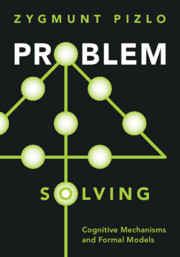Book contents
- Problem Solving
- Problem Solving
- Copyright page
- Dedication
- Contents
- Figures
- Tables
- Preface
- Chapter 1 Problem Solving
- Chapter 2 Animal Problem Solving
- Chapter 3 Modern Research on the Human Ability to Solve Problems that Have Large Search Spaces
- Chapter 4 The Exponential Pyramid Representation that Compensates for Exponentially Large Problem Spaces
- Chapter 5 Heuristic Function, Distance, and Direction in Solving Problems
- Chapter 6 Insight and Creative Thinking
- Chapter 7 Inference in Perception
- Chapter 8 Cognitive Inferences, Mental Representations
- Chapter 9 Theory of Mind
- Chapter 10 Solving Problems in Physics and Mathematics
- Chapter 11 Summary and Conclusions
- References
- Index
Chapter 11 - Summary and Conclusions
Published online by Cambridge University Press: 23 June 2022
- Problem Solving
- Problem Solving
- Copyright page
- Dedication
- Contents
- Figures
- Tables
- Preface
- Chapter 1 Problem Solving
- Chapter 2 Animal Problem Solving
- Chapter 3 Modern Research on the Human Ability to Solve Problems that Have Large Search Spaces
- Chapter 4 The Exponential Pyramid Representation that Compensates for Exponentially Large Problem Spaces
- Chapter 5 Heuristic Function, Distance, and Direction in Solving Problems
- Chapter 6 Insight and Creative Thinking
- Chapter 7 Inference in Perception
- Chapter 8 Cognitive Inferences, Mental Representations
- Chapter 9 Theory of Mind
- Chapter 10 Solving Problems in Physics and Mathematics
- Chapter 11 Summary and Conclusions
- References
- Index
Summary
This concluding chapter summarizes the key concepts discussed in this book. Once problem solving is accepted as any goal-directed activity, it becomes clear that problem solving can be viewed as a framework for discussing all of our cognitive functions. Mental representations are important not only because they can be changed and lead to insight. Abstract mental representations also lead to goal-directed actions in which mental functions can cause physical actions. The AI community is no longer surprised by this fact, so the time has come for the cognitive community to accept it, too. This book puts forth a conjecture that the symmetry of a problem representation is the key to solving problems intelligently, that is, the way humans solve them. Symmetry is essential in scientific discovery, in ordinary insight problems, and in combinatorial optimization problems as well. Combinatorial optimization problems have enormous search spaces, but humans know how to avoid performing search by using a direction. This is analogous to the way a least-action principle operates in physics. The path that requires the least effort can be produced in a step by step process where the next step is made without considering alternatives. All of this makes it clear, finally, why intuitive physics is real: mathematical concepts of symmetry and constrained optimization underlie both cognitive functions and the natural laws. These concepts have also been used in most engineering applications. This fact justifies the optimism that AI systems should be able to emulate human intelligence.
Keywords
- Type
- Chapter
- Information
- Problem SolvingCognitive Mechanisms and Formal Models, pp. 175 - 182Publisher: Cambridge University PressPrint publication year: 2022



